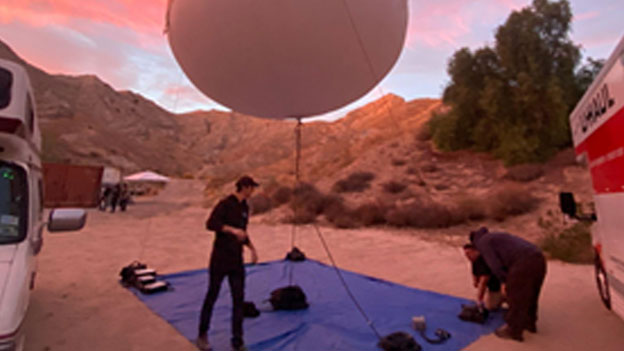- Can you share experiences from projects where you had to navigate challenging environmental conditions, and how it influenced your cinematography?
Certainly. I’ve worked on several projects where challenging environmental conditions presented significant obstacles to overcome. For example, shooting in remote desert locations with extreme temperatures and harsh sunlight required careful planning and adaptation of cinematographic techniques. In these situations, I often think about creative solutions such as using diffusers and reflectors to soften the harsh light, adjusting camera settings to compensate for the high contrast, and working with the 1st AD to schedule shoots during optimal lighting conditions. Despite the challenges, these environmental conditions also provided unique opportunities to capture stunning visuals and evoke a sense of authenticity and realism in the storytelling.
- How do you adapt your visual approach when working in diverse locations, from extreme climates to unique landscapes?
Adapting my visual approach when working in diverse locations involves understanding the unique characteristics and challenges of each environment and tailoring my cinematographic techniques accordingly. Whether it’s capturing the stark beauty of a snow-covered landscape, the vibrant colors of a tropical jungle, or the rugged terrain of a mountainous region, I draw inspiration from the natural surroundings and incorporate elements of the environment into my visual storytelling. This may involve adjusting lighting setups, framing compositions to highlight key features of the landscape, and embracing the natural elements to enhance the mood and atmosphere of the scene.
- Can you share insights into capturing the essence of different seasons and climates in your visual storytelling?
Capturing the essence of different seasons and climates in visual storytelling requires a nuanced understanding of the unique characteristics and mood associated with each season. Whether it’s the warm hues of autumn, the crispness of winter snow, or the vibrant colors of spring, I draw inspiration from the changing seasons to inform my visual approach. This may involve adjusting color palettes, lighting setups, and composition techniques to reflect the mood and atmosphere of the season. By embracing the seasonal elements and incorporating them into my cinematography, I can evoke a sense of time and place that enhances the overall storytelling experience.
- What challenges do you face when shooting outdoors, and how do you overcome them?
Shooting outdoors presents a unique set of challenges, from unpredictable weather conditions to logistical constraints and environmental factors. One common challenge is dealing with changing light conditions throughout the day, which can affect exposure and consistency in visual continuity. To overcome this challenge, I often employ techniques such as using neutral density filters to control exposure, adjusting camera settings on the fly, and planning shoots around optimal lighting conditions. Additionally, I collaborate closely with the production team to anticipate potential challenges and develop contingency plans to ensure a smooth and successful shoot.
- Can you discuss the impact of weather conditions on your visual choices and the overall tone of a project?
Weather conditions have a significant impact on my visual choices and the overall tone of a project. For example, bright sunlight may create harsh shadows and high contrast, evoking a sense of drama and intensity, while overcast skies may produce soft, diffused lighting that conveys a more subdued and melancholic mood. I adapt my cinematographic techniques to complement the weather conditions, adjusting lighting setups, framing compositions, and camera movements to enhance the mood and atmosphere of the scene. By embracing the natural elements and incorporating them into my visual storytelling, I can create a more immersive and authentic viewing experience that resonates with audiences on an emotional level.
- How do you use the environment to create atmosphere and enhance the storytelling in your cinematography?
The environment plays a crucial role in setting the tone, mood, and atmosphere of a scene, and as a cinematographer, I leverage the natural elements to enhance storytelling. Whether it’s using the play of light and shadow to evoke a sense of mystery and suspense in a forest at dusk or capturing the vastness and desolation of an arid desert landscape to underscore themes of isolation and survival, I carefully consider how the environment can contribute to the emotional resonance of the narrative. By framing compositions to incorporate the natural surroundings, adjusting lighting to accentuate textures and contours, and incorporating dynamic camera movements to convey a sense of movement and energy, I strive to create immersive visual experiences that deepen audience engagement and enhance the overall storytelling.
- How do you collaborate with nature when capturing visually stunning landscapes or natural phenomena?
Collaborating with nature involves a deep appreciation for the inherent beauty and unpredictability of the natural world, as well as a willingness to adapt and respond to the ever-changing conditions. Whether it’s waiting for the perfect moment to capture the golden light of sunrise over a mist-covered valley or braving the elements to capture the raw power of a thunderstorm, I approach each outdoor shoot with a sense of reverence and respect for the environment. By observing and studying the natural landscape, anticipating changes in weather and lighting conditions, and embracing serendipitous moments of beauty and drama, I strive to collaborate with nature to capture visually stunning landscapes and natural phenomena that inspire awe and wonder.




